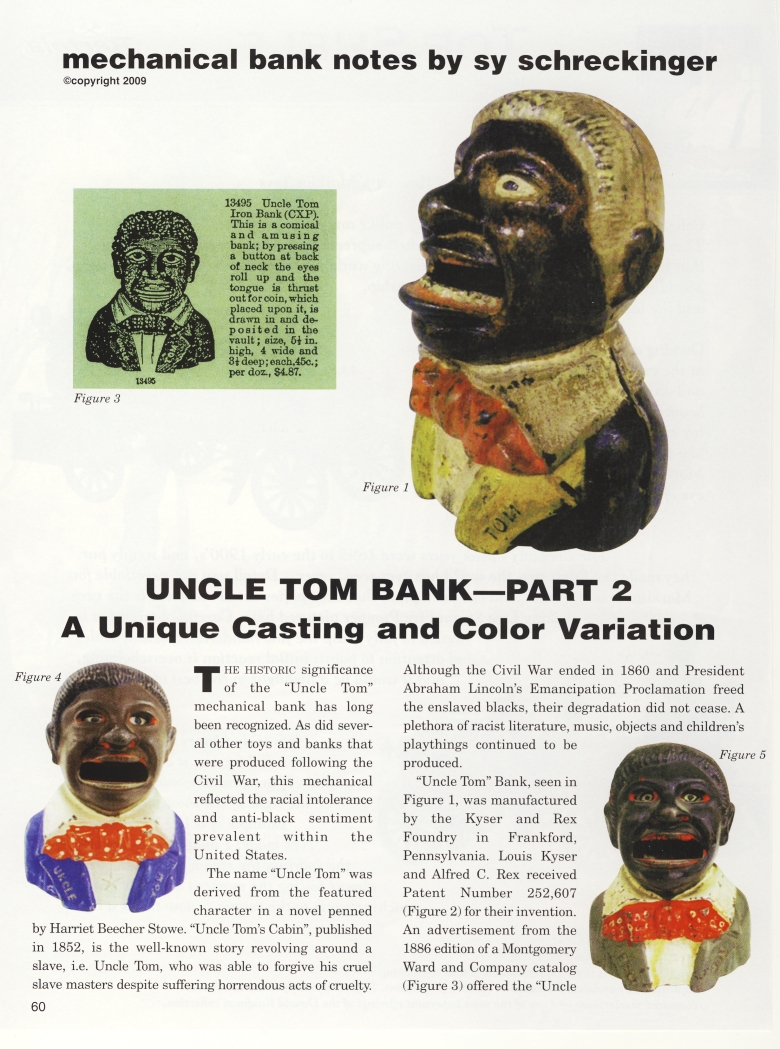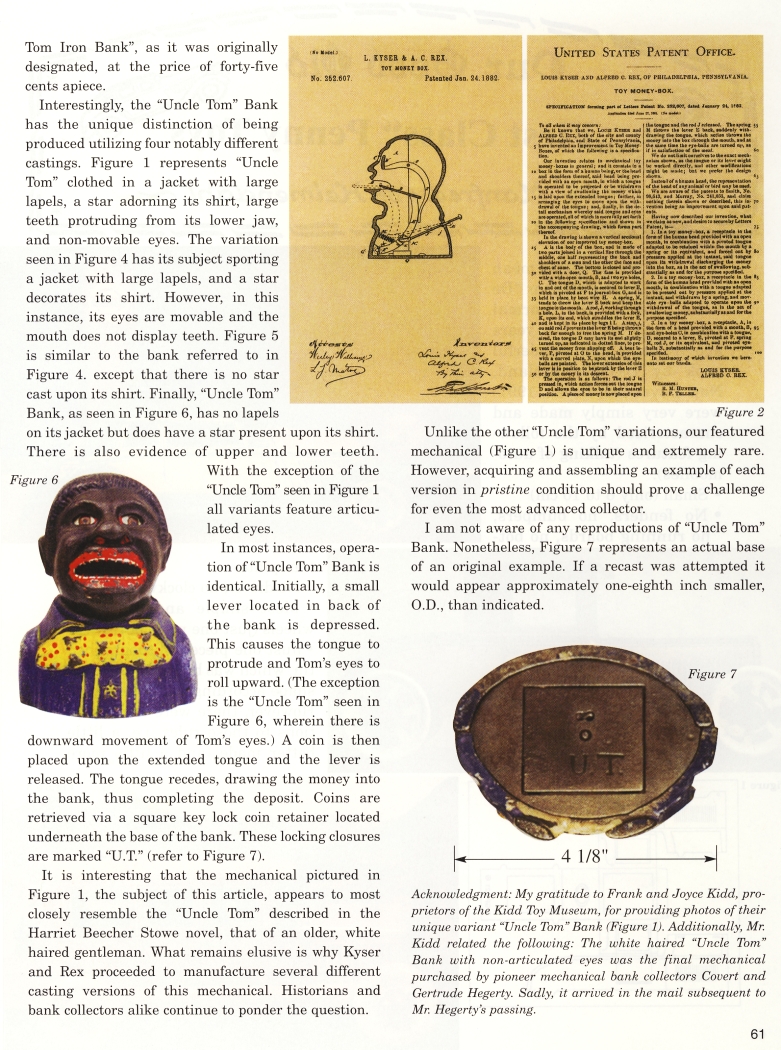|
Uncle
Tom Bank — Part 2
A Unique Casting and Color
Variation
by Sy Schreckinger – ANTIQUE TOY WORLD Magazine – August, 2009
The historic significance of the
"Uncle Tom" mechanical bank has long been recognized. As did several other
toys and banks that were produced following the Civil War, this mechanical
reflected the racial intolerance and anti-black sentiment prevalent within
the United States.
The name "Uncle Tom" was derived from the featured character in a
novel penned by Harriet Beecher Stowe. "Uncle Tom's Cabin", published
in 1852, is the well-known story revolving around a slave, i.e. Uncle Tom,
who was able to forgive his cruel slave masters despite suffering
horrendous acts of cruelty. Although the Civil War ended in 1860 and
President Abraham Lincoln's Emancipation Proclamation freed the enslaved
blacks, their degradation did not cease. A plethora of racist literature,
music, objects and children's playthings continued to be produced.
"Uncle Tom" Bank, seen in Figure 1, was manufactured by the Kyser and
Rex Foundry in Frankford. Pennsylvania. Louis Kyser and Alfred C. Rex
received Patent Number
252,607 (Figure 2) for their invention. An
advertisement from the 1886 edition of a Montgomery Ward and Company
catalog (Figure 3) offered the "Uncle Tom Iron Bank", as it was originally
designated, at the price of forty-five cents apiece.
Interestingly, the "Uncle Tom" Bank has the unique distinction of
being produced utilizing four notably different castings. Figure 1
represents "Uncle Tom" clothed in a jacket with large lapels, a star
adorning its shirt, large teeth protruding from its lower jaw, and
non-movable eyes. The variation seen in Figure 4 has its subject sporting
a jacket with large lapels, and a star decorates its shirt. However, in
this instance, its eyes are movable and the mouth does not display teeth.
Figure 5 is similar to the bank referred to in Figure 4. except that there
is no star cast upon its shirt. Finally, "Uncle Tom" Bank, as seen in
Figure 6, has no lapels on its jacket but does have a star present upon
its shirt. There is also evidence of upper and lower teeth. With the
exception of the "Uncle Tom" seen in Figure 1 all variants feature
articulated eyes.
In most instances, operation of "Uncle Tom" Bank is identical.
Initially, a small lever located in back of the bank is depressed. This
causes the tongue to protrude and Tom's eyes to roll upward. (The
exception is the "Uncle Tom" seen in Figure 6, wherein there is downward
movement of Tom's eyes.) A coin is then placed upon the extended tongue
and the lever is released. The tongue recedes, drawing the money into the
bank, thus completing the deposit. Coins are
retrieved via a square key lock coin retainer located underneath the base
of the bank. These locking closures are marked "U.T." (refer to Figure 7).
It is interesting that the mechanical pictured in Figure 1, the
subject of this article, appears to most closely resemble the "Uncle Tom"
described in the Harriet Beecher Stowe novel, that of an older, white
haired gentleman. What remains elusive is why Kyser and Rex proceeded to
manufacture several different casting versions of this mechanical.
Historians and bank collectors alike continue to ponder the question.
Unlike the other "Uncle Toni" variations, our featured mechanical
(Figure 1) is unique and extremely rare. However, acquiring and assembling
an example of each version in pristine condition should prove a challenge
for even the most advanced collector.
I am not aware of any reproductions of "Uncle Tom" Bank. Nonetheless,
Figure 7 represents an actual base of an original example. If a recast was
attempted it would appear approximately one-eighth inch smaller, O.D.,
than indicated.
Acknowledgment: My gratitude to Frank and Joyce Kidd, proprietors of
the Kidd Toy Museum, for providing photos of their unique variant "Uncle
Tom" Bank (Figure 1). Additionally, Mr. Kidd related the following: The
white haired "Uncle Tom" Bank with non-articulated eyes was the final
mechanical purchased by pioneer mechanical bank collectors Covert and
Gertrude. Hegery. Sadly, it arrived in the mail subsequent to Mr.
Hegerty's passing.
|


